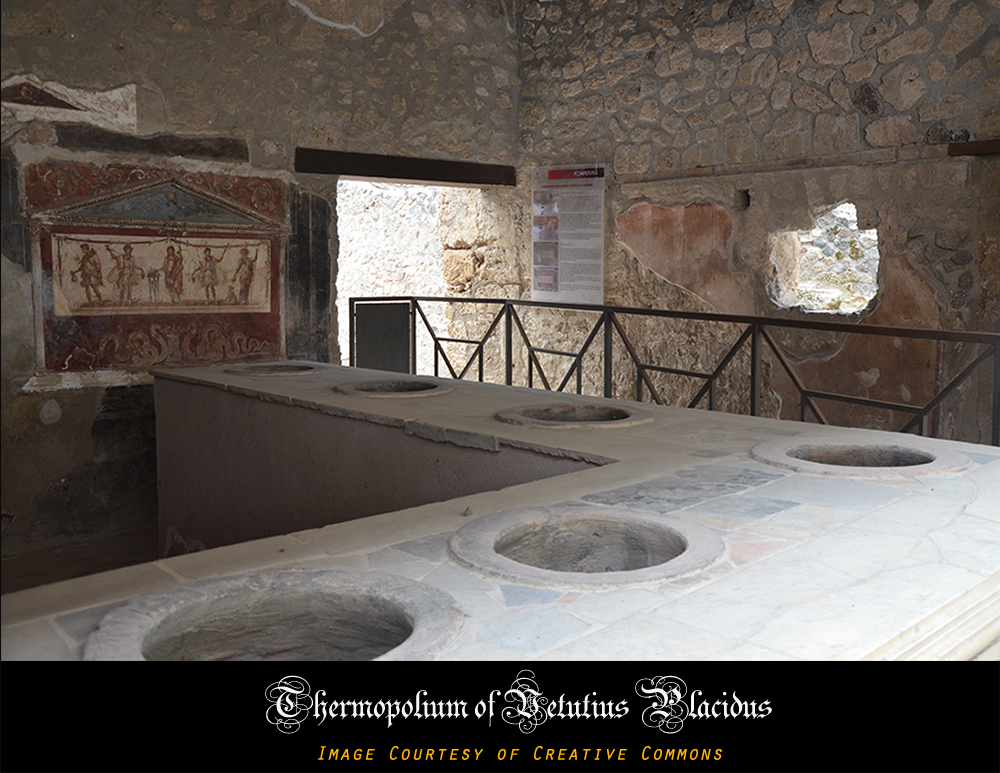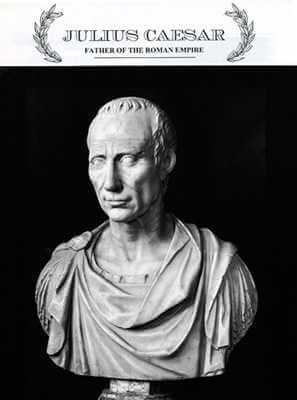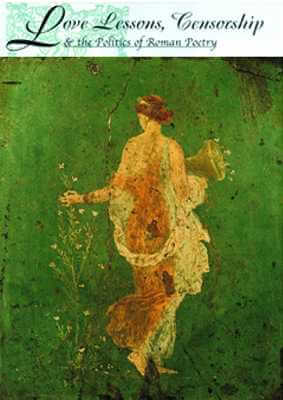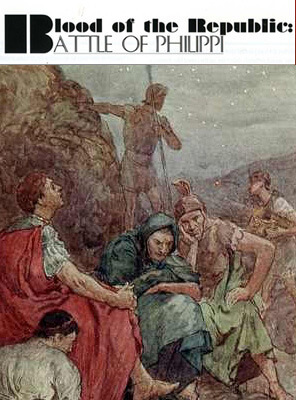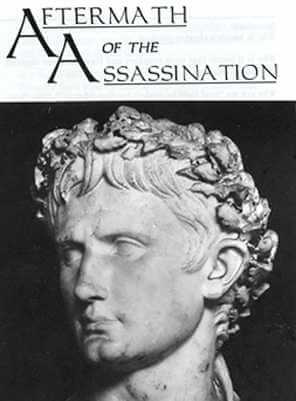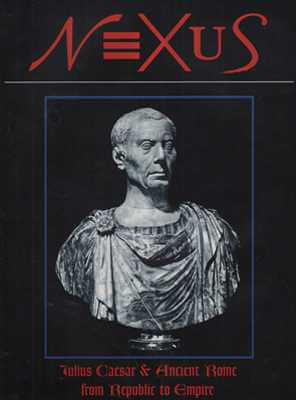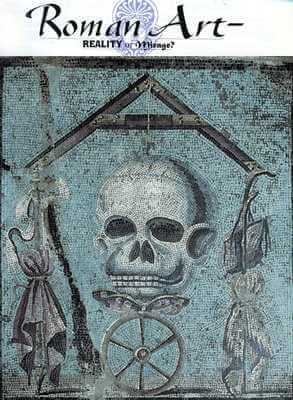NEXUS Connects: Julius Caesar and Ancient Rome. from Republic to Empire
SERVING AMERICAN SECONDARY SCHOOLS FOR 28 YEARS
THE COLLEGE BOARD
“The nine chapters in this title explore the historical Caesar and Shakespeare’s play as well as Roman culture and politics. The NEXUS Integrated Curriculum Unit series does the research for teachers who want to present major literary works in an interdisciplinary context. Built around periods rather than themes, each is a beautifully produced glossy magazine (over 30 pages with color reproductions) that links the text to the period’s history, music, art, theater, and science to provide “additional entry points into literature.” Supplements and team-teaching guidelines (three for this volume) suggest activities and additional readings in each discipline, all emphasizing the critical skills and analogical thinking that are crucial for success on the SAT and AP Exams.”
TEMPO, Texas Association for the Gifted & Talented
“With an impressive group of contributors and consultants, Publisher/Editor Jesse Bryant Wilder has put together a stunning set of challenging materials that will provide outstanding learning experiences for secondary students.”
GENE MAEROFF, Founder of the Hechinger Institute on Education and Media, Teachers College, Columbia University
“NEXUS is a remarkable publication, one of the best of its kind for promoting interdisciplinary work by students. Each volume reflects careful research and is filled with information that both engages students and advances their understanding of how the disciplines complement each other.” – Gene Maeroff is the former Senior Fellow at the Carnegie Foundation for the Advancement of Teaching and former New York Times” national education correspondent.
NCAIS North Carolina Association of Independent Schools Newsletter
“NEXUS is a visually exciting, reader friendly magazine with chapters contributed by nationally known experts in their fields. Crisp scholarship, challenging activities, and teacher supplements make learning entertaining and challenging. NEXUS brings the past to life by using a lively writing style and colorful or intriguing anecdotes, and by highlighting the ‘story’ in history.”
CLASSROOM NOTES PLUS, NCTE (National Council of Teachers of English)
“Each [NEXUS] volume…is a hybrid of a well-written interdisciplinary textbook and a lively, attractive magazine.”
APPLETON EAST HIGH SCHOOL, Appleton, WI
“I haven’t seen any better material for connecting the curriculum, especially world literature and world history—and I have a lot of experience connecting the curriculum….You can see the editor has really done his research. His love of the material really shows.” – Michael W. Bergen, Communication Arts Chair
VALLEY FORGE HIGH SCHOOL, Parma, OH
“Even students who are difficult to manage are captivated by NEXUS magazines.” – Dr. Linda Meixner, English teacher
BALDWIN-WOODVILLE HIGH SCHOOL, Baldwin, WI
“Each volume provides research that any teacher would love to do, but doesn’t have the time to do, and the fact that NEXUS does it for us is very valuable.” – Marti Koller
IMMACULATE HEART OF MARY HIGH SCHOOL, Westchester, IL
“We have found the NEXUS volumes wonderful. They’ve been used in a number of classes in 10th, 11th and 12th grade, including our sophomore World Culture class, which incorporates World Literature and World History. We particularly like the correlations to art, and the students like to see the connections between different subject areas. They find that very interesting. We also find that NEXUS is particularly valuable to visual learners who are not engaged by traditional means.” – Susan Ryan, English Chair”
(SEE TEXT SAMPLES BELOW IN GREEN.)
EVERY PAGE CAPTIVATES STUDENTS and STIMULATES CRITICAL and CREATIVE THINKING.
NEXUS Cross-Curricular Connections in each Lesson Deepen Students’ Understanding of both the Play and Period.
The lessons in Julius Caesar and Ancient Rome enable students to conquer Shakespeare’s figurative language without paraphrasing it. This interdisciplinary NEXUS volume includes a dramatic reenactment of the Battle of Philippi based on primary sources, an examination of partisan politics in post-Caesar Rome, the political role of the gladiatorial games, ancient art, and the physics of the catapult.
Supplements include “Solar Heating in Ancient Rome,” “Seneca’s Influence on Shakespeare,” and “Spartacus, the Gladiator General.” Lesson Plans include “Caesar’s Last Mile – Writing Your Own Scene” & “Portia-Calpurnia Meetup (Writing Your Own Scene).
Part of the reason the NEXUS approach is so effective is because it not only connects disciplines, it also connects learning to students’ emotional and experiential networks (see The Harlem Renaissance text samples in green, the Julius Caesar text sample under “Lesson on Shakespeare’s Language and the Writings of Julius Caesar,” Antigone text samples: “Antigone’s Challenge: Democracy or Dictatorship” and “A Recipe for Tragedy: Aristotle and Oedipus Rex,” and the Macbeth sample text under “Lesson on Macbeth Themes: Fatal Passion and the War Within.”)
Aligned with Common Core Standards. For secondary students.
CLICK IMAGE TO ENLARGE
Photographs of Roman Arena in Nimes, France and Triumphal Arch in Orange, France by Gloria Wilder
Julius Caesar Lessons and Lesson Plans Part I – Figurative Language in the Play and Roman Literature


Lesson on Shakespeare’s Language and the Writings of Julius Caesar, Part I – 4 Pages & Activities
Students learn to recognize, explicate and appreciate Shakespeare’s complex figurative language by using a 4-step explication method that satisfies Common Core Standards and serves as a rigorous mental aerobics for students that will dramatically upgrade their reading skills. Also, students learn to explore and recognize the relevance and universality of Shakespeare’s psychological observations and analogous insights made by the real Julius Caesar in his Civil War by linking them resonantly to their own lives.
This chapter satisfies CCSS.ELA-LITERACY.RL.1, RL..4, RL.7, and RL.9 (for 9-10 and 11-12)
For more on Shakespeare’s figurative language see Macbeth & the Dark Ages and Romeo and Juliet and the Renaissance.

Julius Caesar Language Lesson, Part II: Contrasts and Opposites
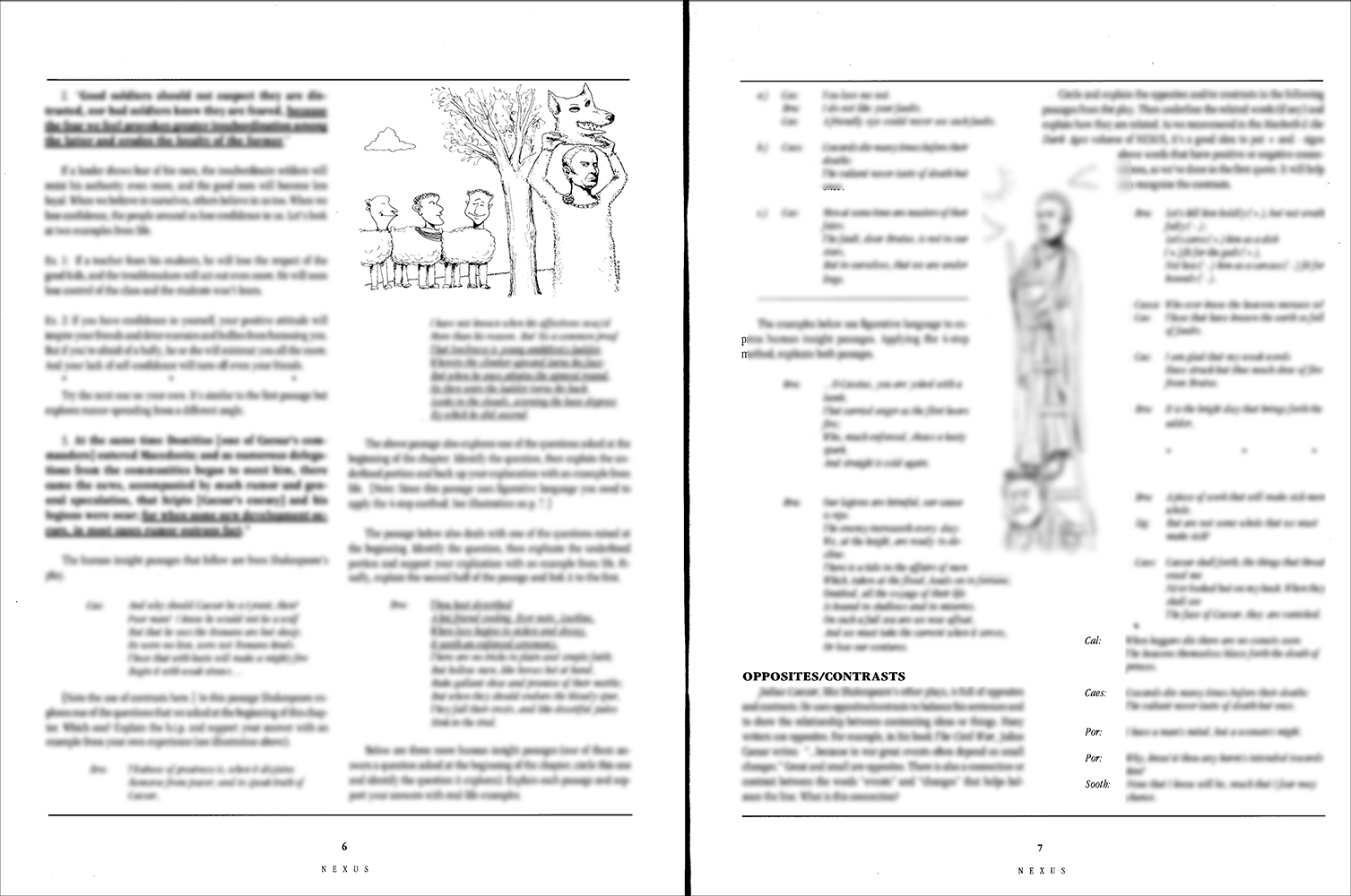
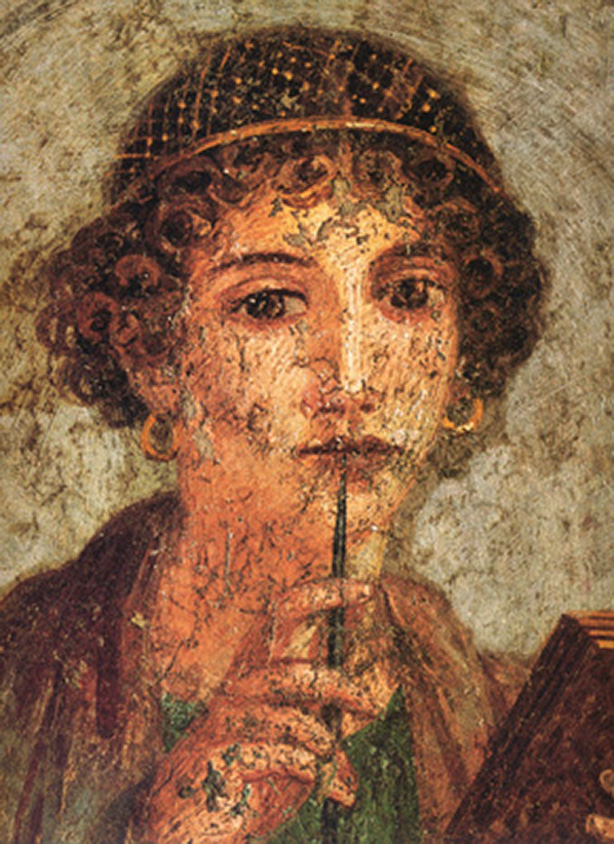
Roman Poetry Lesson: Virgil, Horace & Ovid – 4 Pages & Activities
In this fascinating and engaging lesson students examine poems by Horace that discuss (often sarcastically) the oppressive class system in Ancient Rome, which Horace links to vanity and pride (and which we ask students to compare to modern-day cliques). Students also explore love poems by Ovid, literary censorship under Augustus, and poems that kowtow to the emperor, in this case, Augustus.
(Visit the Poetry Foundation website for excellent bios on Horace and Ovid.)
The poetry excerpts we’ve selected paint a vivid picture of Roman social life, providing students with a rich context for Shakespeare’s tragedy and helping them to better understand and appreciate the power struggles in Julius Caesar and their political fallout.
This chapter is aligned with the following Common Core Standards: CCSS.ELA-LITERACY.CCRA.R.1, R.2, R.3, R.7, R.8, and R.9 (for 9-10 and 11-12).
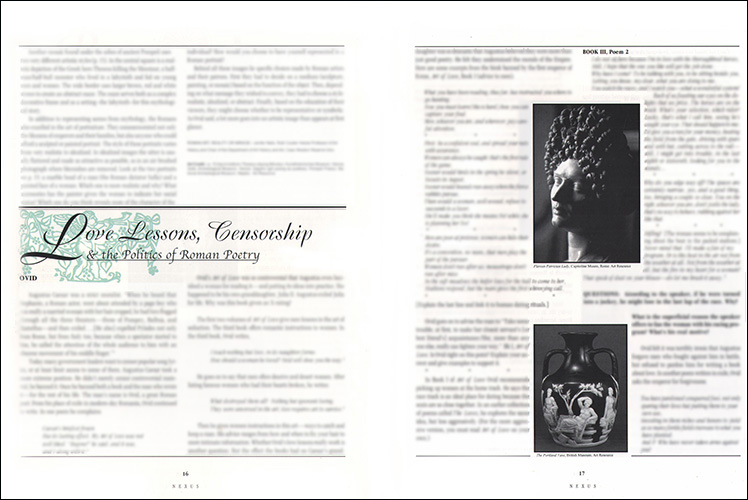
Julius Caesar Lessons and Lesson Plans Part II – All Roads Lead to Roman History

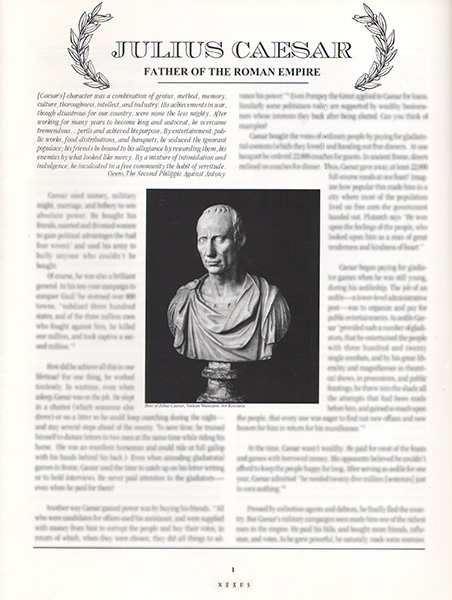
 Julius Caesar History Lesson, General of Generals – 4 Pages
Julius Caesar History Lesson, General of Generals – 4 Pages
This lesson introduces students to the flesh-and-blood Caesar, quoting substantially from primary sources, including Cicero’s letters and Caesar’s writings.
“This chapter draws on compelling details from Sallust, Appian, Dio Cassius, Cicero, and Plutarch to illustrate Caesar’s brilliance as well as his deviousness. A subsection on Caesar’s self-confidence and his vanity sums up his contradictions smartly, concluding where Shakespeare’s play begins.” – The College Board
This lesson is aligned with the following Common Core Standards: CCSS.ELA-LITERACY.CCRA.R.1, R.2, R.3, R.7, R.8, and R.9 (for 9-10 and 11-12).
TEXT SAMPLE:
“Caesar used money, military might, marriage, and bribery to win absolute power. He bought his friends, married and divorced women to gain political advantages (he had four wives), and used his army to bully anyone who couldn’t be bought.”
“Of course he was also a brilliant general. In his ten-year campaign to conquer Gaul, he stormed over 800 towns, ‘subdued three hundred states, and of the three million men who fought against him, he killed one million, and took captive a second million.'”
“How did he achieve all this in one lifetime? For one thing,he worked tirelessly. In wartime, even when asleep, Caesar was on the job. He slept in a chariot (which someone else drove) or on a litter so he could keep marching during the night – and stay several steps ahead of the enemy. To save time, he trained himself to dictate letters to two men at the same time while riding his horse. (He was an excellent horsemen and could ride at full gallop with his hands behind his back.) Even when attending gladiatorial games in Rome, Caesar used the time to catch up on his letter writing or to hold interviews. He never paid attention to the gladiators – even when he paid for them…”
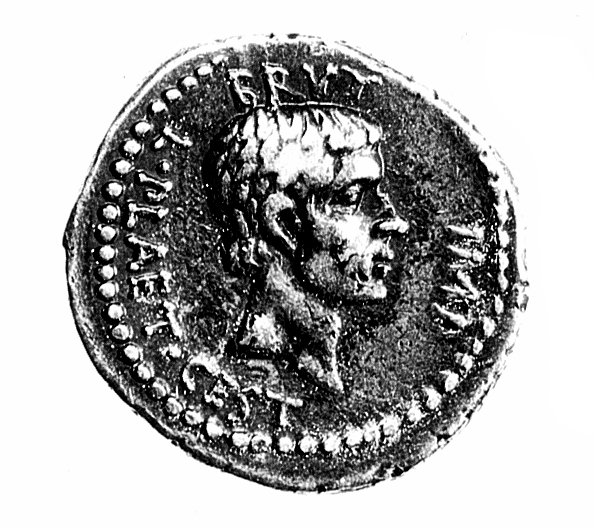
 The Noblest Roman – 3 Pages
The Noblest Roman – 3 Pages
Using primary sources, students examine the relationships between the real Brutus, Caesar, Cassius and Portia. Understanding the backstories of Shakespeare’s Julius Caesar (the soap opera behind the scenes) makes the tragedy much more compelling and relevant for students. In this lesson and the subsequent two-part module “Aftermath of the Assassination” on Antony, Octavius and Cicero, students also investigate the nature of political alliances (what drives them) and the motivations and machinations of clever politicians and demagogues, which will help them to intelligently negotiate today’s complex political terrain.
This lesson aligns with CCSS.ELA-LITERACY.CCRA.R.2, R.3, R.7, and R.9 (for 9-10 and 11-12)
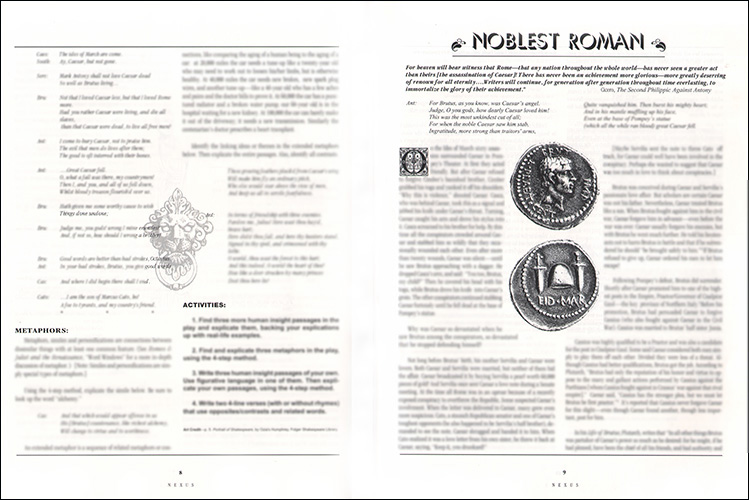

 Mark Antony and Octavius, “Aftermath of the Assassination” (a two-part chapter and lesson – see below for Part II) – 3.5 Pages
Mark Antony and Octavius, “Aftermath of the Assassination” (a two-part chapter and lesson – see below for Part II) – 3.5 Pages
In this dramatic lesson students examine the post-assassination alliance and subsequent power struggle between the historical Mark Antony and Octavius/Augustus, comparing and contrasting Shakespeare’s account with those of ancient sources. The lesson also explores how the young Octavius nurtured a relationship with Cicero (despite Cicero’s support of the assassins) to leverage power against Antony.
Aligns with CCSS.ELA-LITERACY.CCRA.R.7, and R.9 (for 9-10 and 11-12).
TEXT SAMPLE:
“Brutus’ army was a little smaller than Octavius’, but his soldiers were better dressed. Brutus gave his men armor dazzling with gold and silver decorations. He believed beautiful armor would fire up the men who fought for glory, while the money-hungry would fight harder to protect their expensive armor.”
“By contrast, Octavius’ men looked shabby. He gave them plain armor, a little corn and five drachmas for pay. Octavius and Antony were short on cash and food. Brutus had plenty of both. ‘He distributed a great number of beasts for sacrifice to every regiment and….’ Thanks to these gifts Brutus’ men were more eager to fight than Octavius’. Unfortunately for Brutus and Cassius, many of their men had been Julius Caesar’s soldiers. Their new commanders feared they might switch sides when Caesar’s heir, Octavius took the field against them….”
“Plutarch says the Battle of Philippi was the biggest battle in Roman history….Four powerful armies fought at Philippi. Octavius’ legions faced those of Brutus on the right wing. Antony’s troops confronted Cassius’s men on the left. Brutus and Cassius’ armies were camped on two hills about one mile apart. They had arrived at Philippi first and occupied the best position. Mountains protected them on one side, marshes on the other…”

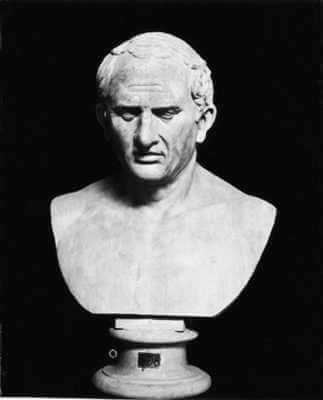
 Lesson on the “Aftermath of the Assassination” Part II – Cicero: Orator, Republican, and Proscribed Man
Lesson on the “Aftermath of the Assassination” Part II – Cicero: Orator, Republican, and Proscribed Man
Students read selected portions of Cicero’s masterful Second Philippic that illustrate the power struggle between Cicero and Antony (the struggle between a true Republican and a demagogue), demonstrate the power of political rhetoric, highlight and elucidate descriptions of Antony in the play by Caesar (“Antony that revels long o’nights”) and by Cassius who calls Anthony “a masker and a reveller,” and help students understand Octavius’ betrayal of Cicero whose proscription (they will learn from this lesson) was demanded by Antony for personal reasons.
MESSALA: …by proscription and bills of outlawry,
Octavius, Anthony, and Lepidus
Have put to death an hundred senators.
BRUTUS: Therein our letters do not well agree;
Mine speak of seventy senators that died
By their proscriptions. Cicero being one.
CASSIUS: Cicero one!
MESSALA: Cicero is dead,
And by that order of proscription.
TEXT SAMPLE:
“The conspirators plotted to rid Rome of its tyrant, but they forgot to devise a plan for saving the Republic after Caesar’s fall. Maybe they thought the gears of he old system would start turning again on their own.”
“Two days after the assassination, Antony, Cicero and others persuaded the Senate to grant amnesty to the conspirators. This must have made Cassius and Brutus feel safe enough to lower their guard. But while they were relaxing, Antony plotted against them. After Antony’s funeral speech – which incited a mob to burn the houses of the conspirators – Brutus and Cassius fled Rome. They planned to return when the mob calmed down, so they remained in Italy for five months to monitor the situation.”
“By mid-June, Brutus and Cassius felt the Roman masses had quieted down enough to return. But while preparing their trip, they learned that swarms of Caesar’s veterans had poured into Rome – possibly at Antony’s invitation. According to rumors, the soldiers planned to ambush them when they returned. Alarmed, they wrote to Antony [letter quoted]…No one knows if Antony wrote back. But two months later…”
This module meets Common Core CCSS.ELA-LITERACY.RL.9-10.4 and CCSS.ELA-LITERACY.CCRA.R.1, R.3, R.7 and R.9 (for 9-10 and 11-12).

 Battle of Philippi – Acts IV and V Lesson – 2 Pages
Battle of Philippi – Acts IV and V Lesson – 2 Pages
Often students find the Battle of Philippi section of Julius Caesar tedious and uninteresting. “Blood of the Republic, Battle of Philippi” is an exciting narrative re-enactment of the actual battle, based on ancient accounts by Plutarch, Appian, Dio Cassius, and modern scholarship, which The College Board states “elucidates Act V of Shakespeare’s play bringing it vividly to life for students.”
This chapter meets Common Core CCSS.ELA-LITERACY.CCRA.R.3 and R.9 (for 9-10 and 11-12).
TEXT SAMPLE:
“Four armies fought at Philippi. Octavius’ legions faced those of Brutus on the right wing. Antony’s troops confronted Cassius’ men on the left. Brutus and Cassius’ armies were camped on two hills about one mile apart. They had arrived at Philippi first and occupied the best position. Mountains protected them on one side, marches on the other. Furthermore, they were close to the sea; their navy could bring in fresh supplies at a moment’s notice. Antony and Octavius camped in an unprotected low-lying area, and didn’t have direct access to the sea. They needed to win quickly or they would run out of food and water. ”
“With Antony and Octavius’ poor supply lines, there was little reason for the Republicans to fight. If they waited long enough, they could starve out the enemy….”
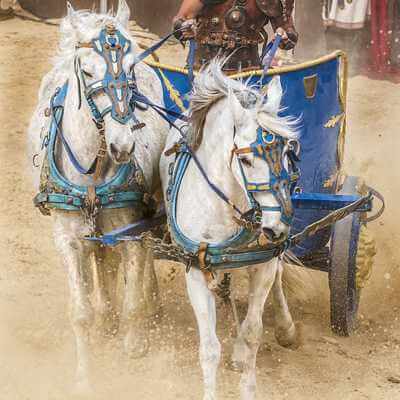
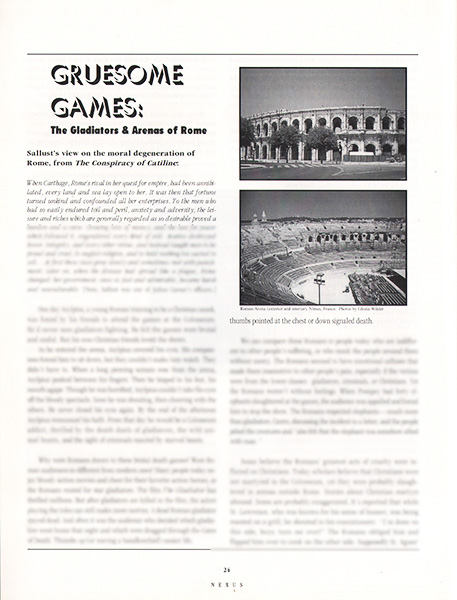
 Lesson on the Politics of the Gladiatorial Games – 5 Pages
Lesson on the Politics of the Gladiatorial Games – 5 Pages
Students explore the Roman games and their political functions from the time of Julius Caesar to the reign of Commodus with dramatic details and accounts from Dio Cassius, Seutonius, and Cicero.
TEXT SAMPLE:
“[Julius] Caesar and Pompey made gladiator games a key part of their political campaigns. People came to expect gladiatorial games in any Roman election. Today we look forward to national political rallies on television. The Romans expected blood duels, paid for by the candidates. The more dramatic the duels, the more votes the candidate usually got…”
“But Pompey had turned people off by slaughtering elephants. Caesar, on the other hand, knew how to turn on the crowds. He introduced two new types of gladiators: the Gallic Swordsman and the British charioteer. Both were modeled on enemies he’d fought in the field. When the crowds watched Gallic Swordsmen or British charioteers battle it out in Caesar’s games, they were able to relive their great general’s battles.”
“The games weren’t the only way Julius Caesar bought votes and friends…”
“Augustus (formerly Octavius), the first Roman emperor, linked the games and politics even more than Julius Caesar had. During his long reign (31 BC – AD 14), Augustus ruled that gladiator combat in Rome could only be staged by praetors (the second highest Roman magistrates who served as judges). Praetors were directly responsible to the emperor, which made the games a branch of imperial policy.
To win the people’s favor Augustus added fifteen more holidays, bringing the total to 153 per year in Rome….Suetonius [quoted earlier in the chapter] says, ‘None of Augustus’ predecessors had ever provided so many, so different, or such splendid public shows.’ The games became so embedded in Roman life that when Tiberius, the second emperor, tried to cancel them, he lost favor…”
Julius Caesar Lessons and Lesson Plans Part III – Roman Art and Science

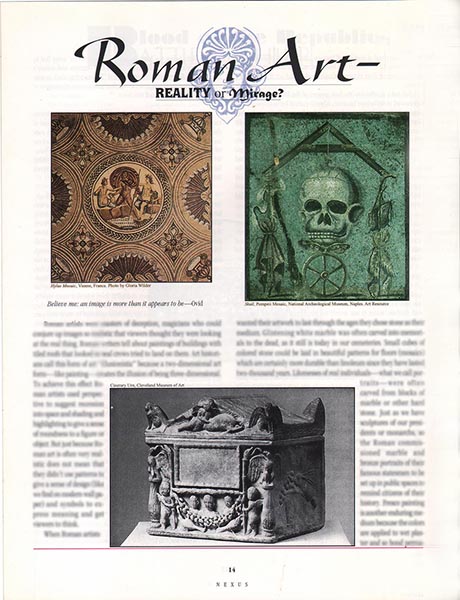
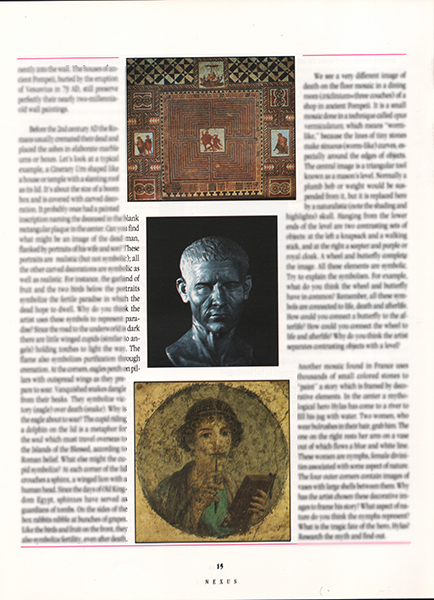
Roman Art Lesson: Mirror or Mirage – 2.5 Pages & Activities
Students learn to read Roman symbols, visual metaphors and contrasts in Roman art. For more see NEXUS Art, Roman Paintings, Sculptures and Relief – Reality or Mirage.
This section “reinforces figurative language reading skills through wonderful illustrations of illusionistic mosaics, portraiture, and sculpture.” The College Board
This lesson applies Common Core CCSS.ELA-LITERACY.RL.4 and RL.5 to visual art (for 9-10 and 11-12).
TEXT SAMPLE:
“Roman artists were masters of deception, magicians who could conjure up images so realistic that viewers thought they were looking at the real thing. Roman writers tell about paintings of buildings with tiled roofs that looked so real crows tried to land on them….Before the 2nd century A.D., the Romans usually cremated their dead and placed the ashes in elaborate marble urns or boxes. Let’s look at a typical example, a Cinerary Urn shaped like a house or temple with a slanting roof as its lid. It’s about the size of a boom box and covered with carved decoration…[description and questions that guide students through an interpretation of the symbolic decorations follow. The urn is of course depicted in the NEXUS book].”
“We see a very different image of a death on the floor mosaic in a dining room of a shop in ancient Pompeii. It is a small mosaic done in a technique called opus vermiculatum, which means ‘worm-like,’ because the lines of tiny stones in the mosaic make sinuous (worm-like) curves….The central image is a triangular tool known as a mason’s level. Normally a plumb bob or weight would be suspended from it, but it is replaced here by a naturalistic (note the shading and highlights) skull. Hanging from the lower ends of the level are two contrasting sets of objects: at the left a knapsack and a walking stick, and at the right a scepter and purple or royal cloak. A wheel and butterfly complete the image. Try to explain the symbolism (as we helped you do with the Cinerary Urn). For example, what do you think the wheel and butterfly have in common? Remember, all these symbols are connected to life, death, and the afterlife….Why do you think the artist separates contrasting objects with a level?…”
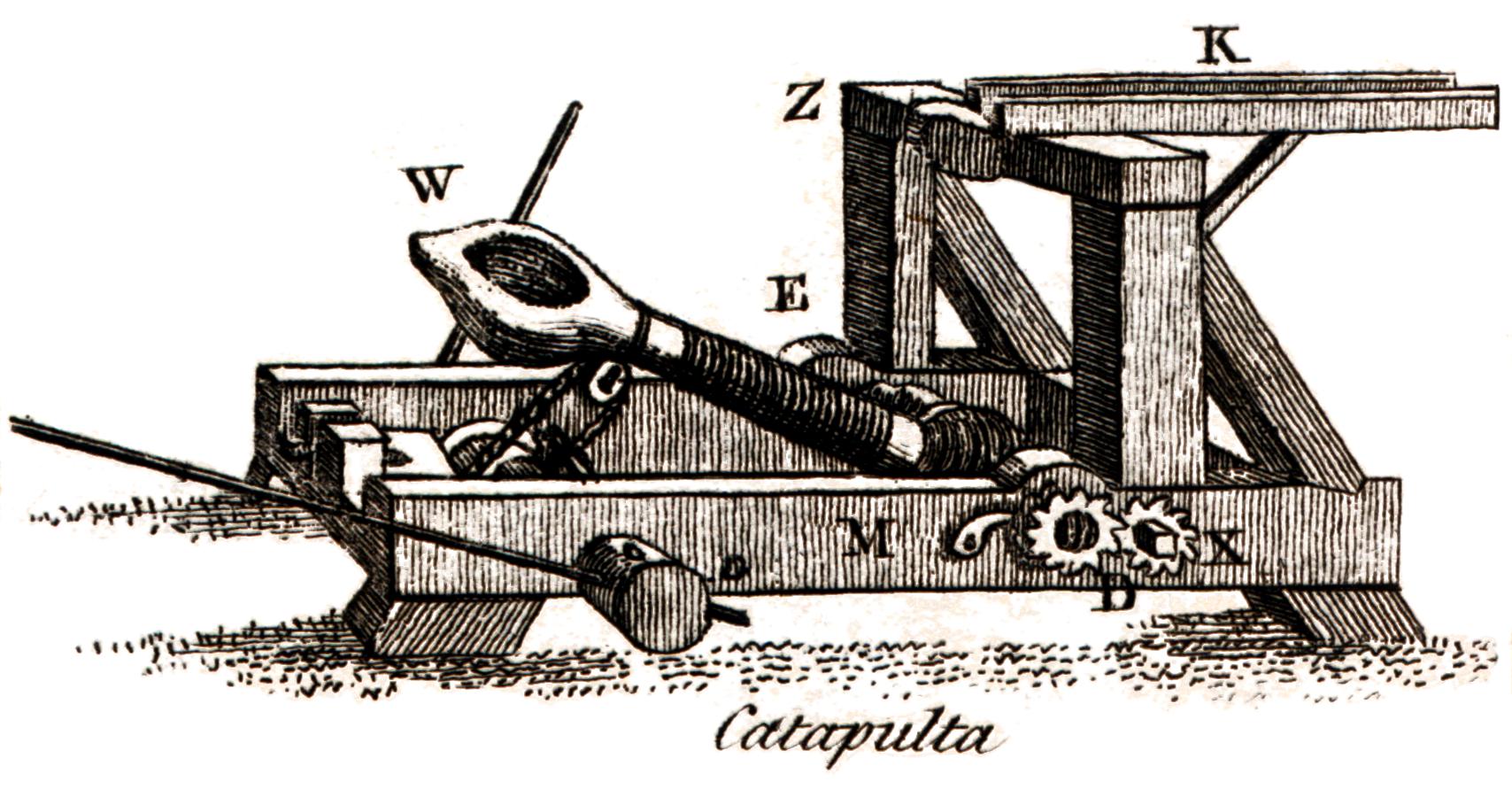
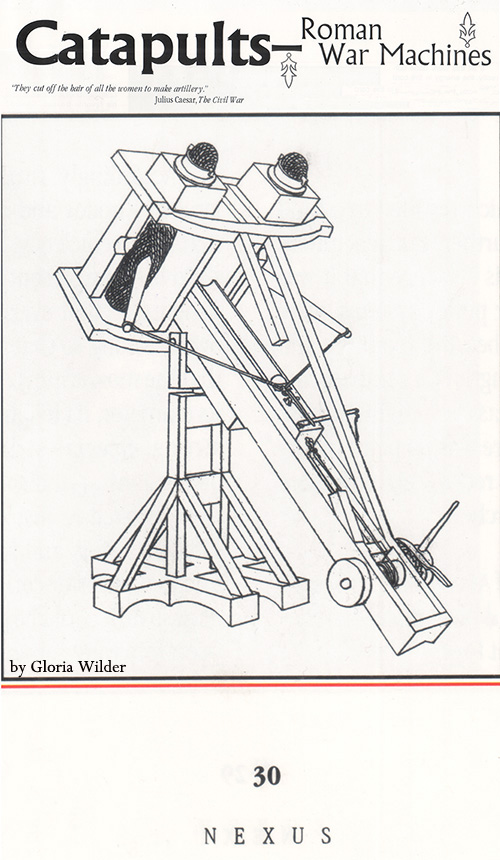
The Physics of the Catapult – 2 Pages & Activities
Historian of technology and Purdue Associate Professor Vernard Foley (a frequent contributor to Scientific American) helps students investigate the physics and math of the catapult, including how to extract cube-roots using calipers, as the Roman’s did, and how to calculate firing distances based on the weight of armatures.
This lesson aligns with Common Core CCSS.ELA-LITERACY.RST.1, RST.3 and RST.8 (for 9-10 and 11-12). It also meets CCSS.ELA-LITERACY.RST.2 and RST.4
TEXT SAMPLE:
HISTORY –
“Within ten years, Julius Caesar stormed over 800 cities in Gaul. Without the catapult this would have been impossible. Before attacking armies had the ability to batter walls with catapults, sieges went on and on and on. According to tradition, the Trojan War lasted ten years – until a wooden horse was dragged into the city with Greek kings hiding in its belly. If the Greeks had had catapults, Troy might have fallen in a day instead of a decade.”
“According to tradition, the first catapults were engineered by research and development teams working for the tyrant Dionysus in the Greek city-state of Syracuse in 399 B.C….
“The next advance in design came during the time of Alexander the Great’s father, Philip of Macedon, around 340 B.C. Another team of engineers re-conceptualized the catapult, leading to its standard ancient form – the form the Romans used and perfected. The sinew layer was stripped off the front of the bow arms and made into strong, highly elastic ropes – like super bungee cords. These ropes were wound tightly around a pair of iron posts mounted in two adjacent eye-sockets on each bow arm…”
PHYSICS –
“Catapults were very complex for their time. The force they contained (the stored energy) was enormous for such compact devices. Therefore they posed major engineering challenges: no one wanted to build a machine which might fail through weakness (not enough material to absorb the strain) or have so much excess material that they were hard to maneuver and wasteful of scarce resources. Above all, catapults should not have inferior range or accuracy so that an army had to endure enemy fire without being able to shoot back…If all this were done correctly, the energy in the cord bundle was proportional to both the square of the angle through which the rigid bow arms are pulled back, and the cube of the diameter of the cord bundle. To determine how much energy was stored in the cord or bungie bundle, you had to calculate…” – by Vernard Foley, Historian of Technology and Science, Purdue University, and frequent contributor to Scientific American
Julius Caesar Lesson Plans and Supplements

SUPPLEMENTS (photocopying NEXUS booklets, lessons and supplements is NOT permitted.)
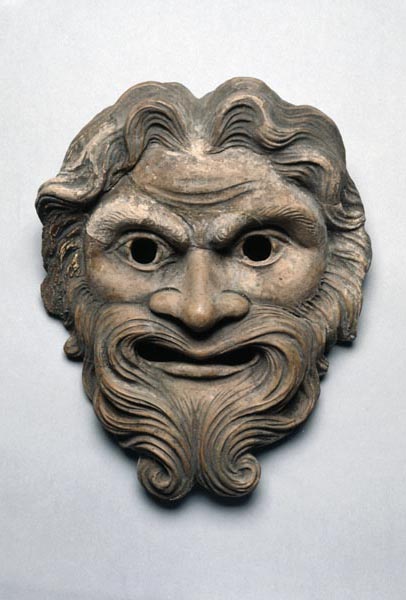
 Supplementary Lesson 1: Spartacus, the Gladiator General
Supplementary Lesson 1: Spartacus, the Gladiator General
This NEXUS supplement chronicles the Spartacus's slave uprising from it's beginnings at the gladiatorial school in Capua, where 78 trainee gladiators overcame their Roman guards with kitchen utensils, to the Slave/Gladiator army's sweeping victories across the Italian peninsula, and to its last stand against the twelve legions of Crassus.
TEXT SAMPLE:
"Some gladiator trainers were cruel to their gladiators. At a school in Capua, run by Lentulus Batiates, the trainee gladiators—most of them Thracians and Gauls—were treated brutally. Two hundred of the trainees plotted an escape. But before they could carry out their plan, they were discovered. Nevertheless, 78 of them invaded the school kitchen, stealing knives and anything else they could use as weapons. Armed with kitchenware, the gladiators fought their way to freedom. While fleeing from the city, they encountered several wagons loaded with gladiator arms. They seized these, then hid in the green slopes of Mount Vesuvius, the volcano that 100 years later would bury the cities of Pompeii and Herculaneum."
"Soldiers from Capua pursued them into the mountains. But the gladiators slaughtered them and confiscated their weapons. Now well-armed, these highly trained fighting machines were a formidable force. What Roman soldier could stand up to a gladiator, even a trainee. After all, Roman soldiers spent more time building roads, bridges and fortifications than fighting. Gladiators practiced combat skills all day long..."
"
 Supplementary Lesson 2: Empire in the Sun, Solar Heating in Ancient Rome
Supplementary Lesson 2: Empire in the Sun, Solar Heating in Ancient Rome
The city of Rome passed laws requiring all structures to be built according to strict laws that took advantage of solar heat.
TEXT SAMPLE:
"To modern tastes the Romans appear a backwards and bloodthirsty people whose influence we are glad to have shed. The movie The Gladiator reminds us of this. Roman games are notorious for their butchery of animals, slaves, and religious radicals like the early Christians. But in other ways the Romans were advanced and found solutions to problems we still wrestle with today. One of these was the use of solar energy. The Romans didn’t have the luxury of electric heating, so they developed efficient ways of holding on to the heat they derived from the sun.
It’s obvious that in the Northern Hemisphere it is the south side of a house or building that gets the most sun. But how many of us live in buildings that take full advantage of this fact? The Roman architect Vitruvius made this a fundamental design feature in his housing recommendations.[1] In developed centers like Rome, laws were passed that prevented anyone from erecting a new building that blocked an older structure’s access to the sun.
On several occasions the Romans planned entire suburbs in which every house faced the southwest, had few openings to the north or east, and included partial walls around the sun-exposed openings to allow the heated air within to circulate rather than to leak away. These partial walls consisted of..."
- by Vernard Foley, Historian of Science and Technology, Purdue University.
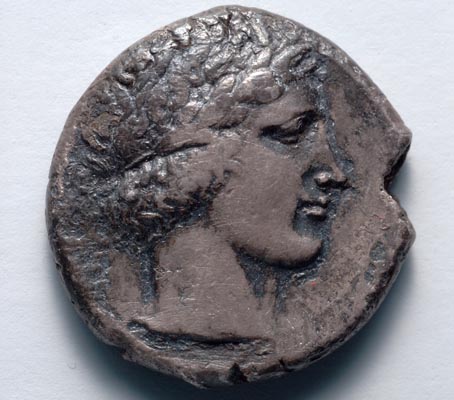
 Advanced Supplementary Lesson: Virtue and Rage, Seneca's Influence on Shakespeare
Advanced Supplementary Lesson: Virtue and Rage, Seneca's Influence on Shakespeare
Students explore ways in which the Roman writer and stoic philosopher Seneca influenced Shakespeare. This supplement is designed for advanced students.
TEXT SAMPLE:
"Seneca’s achievements as a philosopher who had been politically active (at one time he was more or less de facto Roman Emperor), coupled with his stoical suicide, gave his philosophy a prestige comparable with his literary style. This philosophy was Stoicism, one of the great philosophical systems to survive from classical antiquity. Stoicism proved highly congenial to the Renaissance, so much so that there was hardly an intellectual figure in the period – from Pico della Mirandola to Descartes, from Rabelais to Milton − who did not absorb and adapt some part of its canon. So it is hardly surprising that Stoicism should also make its appearance on the stage in one guise or another."
"Early Stoics believed that humans should live in harmony with reason....The Stoic was to be a model of self-possession: deliberate and rational in action, moderate in feeling, stalwart in adversity, and subservient to nothing, like the historical Cato and Shakespeare’s Brutus. When in Act IV, Scene 3, Messala reports to Brutus that his wife Portia has died, he simply says, "Why, farewell, Portia. We must die, Messala./With meditating that she must die once,/I have the patience to endure it now." Stoicism offered a picture of the self in..."
GUIDELINES: The NEXUS guidelines suggest interdisciplinary activities and student-friendly ancillary readings.
NEXUS is a 501(c)(3) nonprofit based in Cleveland, OH. Our mission is to provide schools with outstanding interdisciplinary resources that inspire students to THINK, LINK and IMAGINE
A portion of our proceeds is donated annually to UNICEF'S Audrey Hepburn All Children in School Fund.


